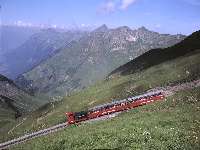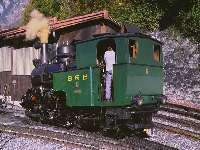
BRB

With the opening of the Brünigbahn the idea of a mountain railway to the
Brienzer Rothorn was developed. The establishment of the society and the
building took place with a tremendous rate for today's conditions: After
only two years of construction the line was already put into operation
in 1892. The two designers, engineer Alexander Lindner and building
contractor Theo Bertschinger were supported by the mountain railway
 pioneer Roman Abt, who had responsibility for equipping the line with
his newly developed double lamella rack. The 640 usually Italian workers
reached the planned last stop at Rothorn Kulm in October 1891. For the
completion of the line thereafter service trains could already be used
over the entire length.
pioneer Roman Abt, who had responsibility for equipping the line with
his newly developed double lamella rack. The 640 usually Italian workers
reached the planned last stop at Rothorn Kulm in October 1891. For the
completion of the line thereafter service trains could already be used
over the entire length.
After a major success with over 11.000 passengers in the first season the BRB quickly got into economical problems. One reason was the competition of the Schynige Platte Bahn (1895) and the Jungfraubahn (1898), another reason was the outbreak of the First World War. Thus the operation of the line was stopped on 1 August 1914 again and was situated for 16 years in the Sleeping Beauty slumber. In 1931, at the high point of the world economic crisis, a new society was found to make a new start.
When most Swiss railways were electrified in the 1940's and 1950's, the
 BRB decided to maintain the steam operation. From 1953 it was thus up to
the operation accommodation of the Furka Cogwheel Steam Railway the only
railway company with regular steam operation in Switzerland. Due to the
age and condition of the machines the BRB bought four diesel locomotives
Hm 2/2, in order to preserve the already 80 year old locomotives and
extend the vehicle park between 1973 and 1897.
BRB decided to maintain the steam operation. From 1953 it was thus up to
the operation accommodation of the Furka Cogwheel Steam Railway the only
railway company with regular steam operation in Switzerland. Due to the
age and condition of the machines the BRB bought four diesel locomotives
Hm 2/2, in order to preserve the already 80 year old locomotives and
extend the vehicle park between 1973 and 1897.
An innovation was the new construction of steam locomotives, which the SLM Winterthur projected in the year 1992. The BRB received three new locomotives, which were built together with ones for the Montreux-Glion-Rochers de Naye-Bahn and the two Austrian railways Hochschneeberg and Schafberg. The locomotives are oil-fired, suitably for one-man operation and more economical by optimal isolation than the old timers of the first period.
Copyright © 2001
Author: Stefan Dringenberg, last change on 2001-02-19